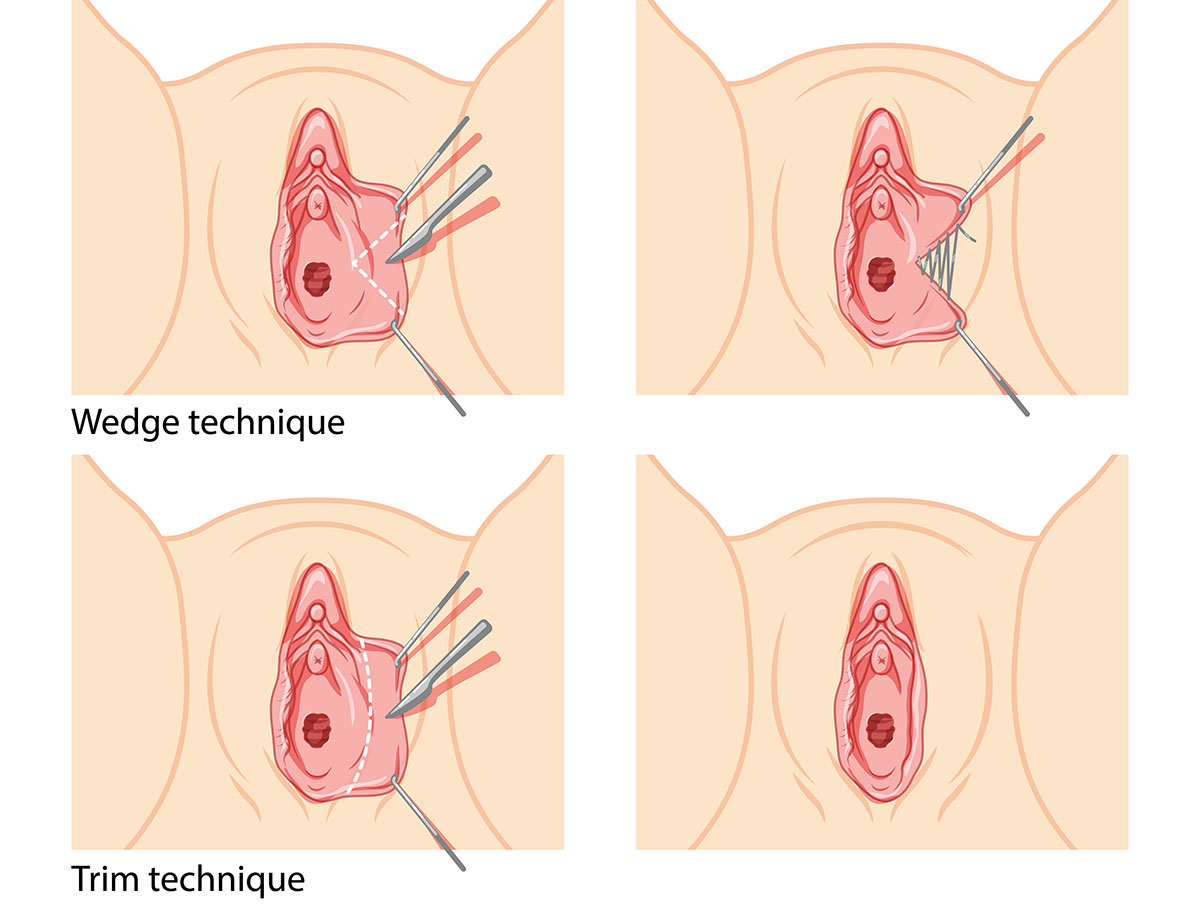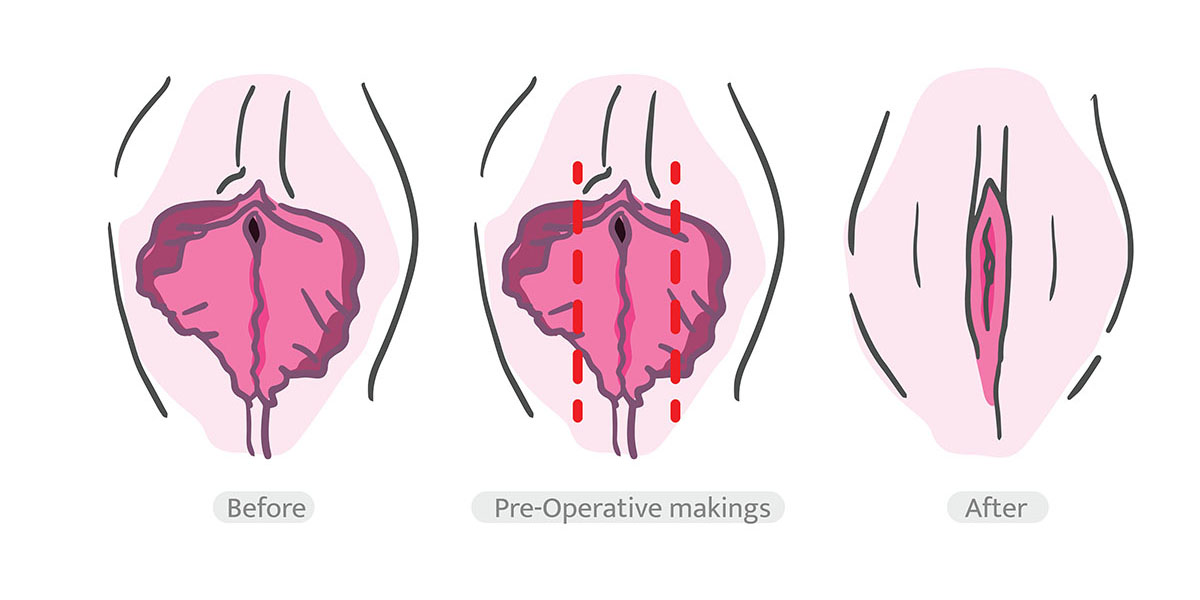Labiaplasty is a surgical procedure designed to reshape or reduce the size of the labia minora (the inner folds of skin surrounding the vaginal opening) and, in some cases, the labia majora. While the procedure is often associated with aesthetics, there are legitimate medical reasons for labiaplasty that go far beyond cosmetic enhancement.
For many women, labiaplasty for medical reasons can significantly improve comfort, hygiene, and overall quality of life. This article provides a scientific and medically accurate exploration of labiaplasty for medical reasons, explaining the distinction between functional and cosmetic motivations.
Understanding the Anatomy and Purpose of Labiaplasty
The labia minora and labia majora serve as protective structures for the vaginal and urethral openings, maintaining moisture balance and reducing friction. However, some individuals experience labial hypertrophy, a condition where the labia minora are elongated or enlarged beyond the natural variation. While mild enlargement is anatomically normal, excessive tissue can lead to discomfort or medical issues.
A labia reduction or labiaplasty for functional impairment aims to address such issues by surgically removing excess tissue while preserving nerve supply and vascular integrity. The procedure is typically performed under local or general anesthesia, using techniques such as the “trim” or “wedge” method to achieve optimal functional and aesthetic outcomes.
In addition to traditional trim and wedge methods, some surgeons now employ radiofrequency or laser-assisted labiaplasty techniques, which can minimize bleeding, enhance precision, and promote faster healing when performed by experienced specialists.
Functional and Medical Reasons for Labiaplasty

1. Chronic Pain and Physical Discomfort
One of the primary medical reasons to have labiaplasty is chronic discomfort caused by enlarged labial tissue. Excess labial tissue can lead to irritation during physical activities such as cycling, running, or sexual intercourse. Friction between the labia and clothing can result in soreness, inflammation, or microtears in the mucosa.
From a clinical perspective, chronic mechanical irritation may trigger local inflammation and neural sensitization, which can exacerbate pain over time. In such cases, labiaplasty for medical reasons can remove the excess tissue responsible for mechanical strain, reducing local nerve compression as well as pain from frictional irritation, thus improving mobility and comfort1.
2. Recurrent Infections and Hygiene Problems
Another well-documented reason to get a labiaplasty is recurrent infection due to poor hygiene accessibility. When excess tissue traps moisture, sweat, and bacteria, it can increase susceptibility to vulvovaginal candidiasis and urinary tract infections (UTIs). Women with enlarged labia may also find it difficult to maintain proper hygiene during menstruation or after urination, further increasing microbial growth risk.
A labiaplasty for functional impairment can enhance local hygiene by allowing better airflow and reducing microbial retention in moist folds. Clinical studies have reported a decrease in the frequency of recurrent vulvovaginal infections following functional labiaplasty procedures2.
3. Pain During Intercourse (Dyspareunia)
Dyspareunia, or painful intercourse, is one of the significant medical reasons to get a labiaplasty. Enlarged labial tissue can be pulled, pinched, or folded during penetration, causing mechanical pain and psychological distress. Persistent pain during intimacy can lead to sexual avoidance, relationship strain, and anxiety.
Functional labiaplasty aims to correct the anatomical imbalance contributing to dyspareunia. By removing redundant tissue and reducing frictional contact, patients report substantial improvements in sexual comfort and pleasure, further contributing to improved genital self-image and reduced distress3.
4. Postpartum or Age-Related Changes
Pregnancy, vaginal childbirth, and hormonal changes from menopause can alter labial size and elasticity. The repetitive stretching of the labia can result in asymmetry or elongation, leading to discomfort and self-consciousness. Women experiencing these postpartum or age-related changes may consider labiaplasty for medical reasons to restore comfort and anatomical balance.
This restorative approach helps alleviate symptoms such as local irritation, rubbing during exercise, or difficulty wearing fitted clothing, offering both physical relief and psychological confidence.
5. Congenital or Traumatic Causes
Some women are born with naturally asymmetric or elongated labia due to congenital variations. Others may experience tissue trauma from sports injuries, accidents, or childbirth tears. In these cases, labiaplasty for functional impairment can restore anatomical function and prevent secondary complications such as chronic inflammation or scar tissue formation.
When performed with precision, the procedure helps normalize tissue structure without compromising sensitivity or natural appearance.
Cosmetic Reasons for Labiaplasty

While many undergo the surgery for labiaplasty’s medical reasons, others seek it for aesthetic refinement. Cosmetic labiaplasty focuses on achieving symmetry, proportion, and a desired aesthetic appearance. Common motivations include:
- Reducing the visible protrusion of the labia minora.
- Achieving a smoother contour for improved confidence.
- Aligning physical appearance with body image preferences.
However, even cosmetic motivations often overlap with functional concerns. A patient may initially seek aesthetic improvement but also experience discomfort that justifies a labiaplasty for medical reasons.
Consultation, Evaluation, and Candidacy
A qualified, board-certified plastic surgeon or gynecologist conducts a comprehensive evaluation to determine whether the indication for surgery is functional or cosmetic. During consultation, anatomical assessment, patient symptoms, and psychological motivations are reviewed.

For patients pursuing labiaplasty for medical reasons, proper documentation may support partial insurance coverage. In contrast, cosmetic cases are typically elective and self-funded. A detailed discussion of expectations, recovery time, and potential risks ensures informed consent and realistic outcomes.
Risks, Recovery, and Outcomes
Although labia reduction is generally safe when performed by an experienced surgeon, it remains a surgical procedure with potential risks such as infection, scarring, bleeding, and altered sensation.
The recovery period usually spans four to six weeks. Patients are advised to avoid physical exertion and sexual activity during this time. When properly executed, labiaplasty has high satisfaction rates, with over 90% of patients reporting improved comfort and body confidence4.
Insurance and Cost Considerations

Insurance coverage for labiaplasty for medical reasons depends on the documented medical necessity. Procedures justified by chronic irritation, recurrent infections, or functional impairment may qualify for coverage, though criteria vary across providers. Cosmetic labiaplasty, performed purely for aesthetic goals, typically requires out-of-pocket payment.
A transparent cost discussion with the surgeon’s office is essential before proceeding.
FAQs
1. What are the most common medical reasons for labiaplasty?
The most common medical reasons for labiaplasty include chronic pain, physical discomfort, hygiene issues, recurrent infections, and pain during intercourse. Each of these can significantly affect one’s quality of life, making labiaplasty for medical reasons a clinically valid and effective treatment option.
2. Can labiaplasty improve hygiene and reduce infections?
Yes. Excess tissue can trap bacteria and moisture, leading to infection. Surgical removal of redundant tissue during labiaplasty for functional impairment enhances airflow, reduces irritation, and helps maintain better hygiene.
3. Is labiaplasty only for cosmetic purposes?
No. While some seek labiaplasty for aesthetic reasons, many undergo the procedure for legitimate medical reasons to have labiaplasty, particularly when labial enlargement interferes with normal daily activities or causes pain.
Empowering Health and Function: A Modern Perspective
The decision to undergo labiaplasty should be rooted in individual needs rather than societal expectations. Understanding the medical reasons for labiaplasty helps women make informed, evidence-based decisions about their health and comfort. Whether performed to correct labial hypertrophy, alleviate discomfort, or restore confidence, labiaplasty for medical reasons remains a medically valid and effective intervention when performed by a skilled professional.

Women deserve access to accurate information and compassionate care that recognizes both functional and emotional dimensions of the procedure. A personalized consultation with a qualified surgeon is the first step toward achieving comfort, confidence, and well-being.
At our state-of-the-art vaginal rejuvenation clinic in New Jersey, we offer advanced labiaplasty surgery using the latest medical techniques for optimal comfort and natural results. Our team provides personalized care, transparent consultations, and flexible payment plans to make treatment accessible. Contact us today to schedule your confidential consultation and restore your confidence and well-being.
References
- Goodman MP. Female genital cosmetic and plastic surgery: a review. J Sex Med. 2011 Jun;8(6):1813-25. doi: 10.1111/j.1743-6109.2011.02254.x. Epub 2011 Apr 14. PMID: 21492397.
- Felicio Yde A. Labial surgery. Aesthet Surg J. 2007 May-Jun;27(3):322-8. doi: 10.1016/j.asj.2007.03.003. PMID: 19341661.
- Sharp G, Tiggemann M, Mattiske J. Psychological Outcomes of Labiaplasty: A Prospective Study. Plast Reconstr Surg. 2016 Dec;138(6):1202-1209. doi: 10.1097/PRS.0000000000002751. PMID: 27879587.
- Goodman MP, Placik OJ, Benson RH 3rd, Miklos JR, Moore RD, Jason RA, Matlock DL, Simopoulos AF, Stern BH, Stanton RA, Kolb SE, Gonzalez F. A large multicenter outcome study of female genital plastic surgery. J Sex Med. 2010 Apr;7(4 Pt 1):1565-77. doi: 10.1111/j.1743-6109.2009.01573.x. Epub 2009 Nov 12. PMID: 19912495.







